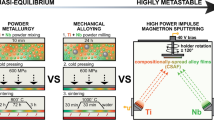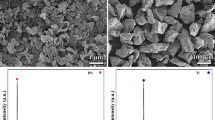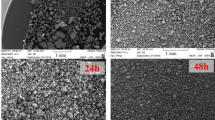Abstract
Dense fully stabilized cubic zirconia, sintered by the spark plasma sintering (SPS) method, was characterized through hardness, fracture toughness, and electrical impedance measurements. The effect of sintering temperature on hardness and fracture toughness was evaluated. Samples sintered at 1200 °C for 5 min, which had crystallite size of <100 nm, exhibited the highest hardness. Impedance measurements showed an increase in bulk contribution relative to grain boundaries as sintering temperature is increased. Calculation of the activation energy for conduction gave a value, 1.13 eV, in agreement with previously published results.
Similar content being viewed by others
References
U. Anselmi-Tamburini, J. Garay, Z.A. Munir, A. Tacca, F. Maglia, and G. Spinolo: Spark plasma sintering and characterization of bulk nanostructured fully stabilized zirconia: Part I. Densification studies. J. Mater. Res. 19, 3255 (2004).
W. Li and L. Gao: Rapid sintering of nanocrystalline ZrO2(3Y) by spark plasma sintering. J. Eur. Ceram. Soc. 20, 2441 (2000).
L.G. Yu, K.A. Khor, S.H. Chan, and X.J. Chen: In Processing and Fabrication of Advanced Materials X, Proceedings of the Tenth International Symposium on Processing and Fabrication of Advanced Materials, Indianapolis, IN, Nov. 5–8, 2001 (ASM International, Warrendale, PA, 2001), p. 33
T. Takeuchi, I. Kondoh, N. Tamari, N. Balakrishnan, K. Nomura, H. Kageyama, and Y. Takeda: Improvement of mechanical strength of 8 mol% yttria-stabalized zirconia ceramics by spark plasma sintreing. J. Electrochem. Soc. 149, A455 (2002).
X.J. Chen, K.A. Khor, S.H. Chan, and L.G. Yu: Preparation yttriastablized zirconia electrolyte by spark plasma sintering. Mater. Sci. Eng. A 341, 43 (2003).
K. Niihara, R. Morena, and D.P.H. Hasselman: Evaluation of KIC of brittle solids by the indentation method with low crack-toindent ratios. J. Mater. Sci. Lett. 1, 13 (1982).
M. Barsoum: Fundamentals of Ceramics (McGraw-Hill, New York, 1997), p. 401.
B.A. Cottom and M.J. Mayo: Fracture toughness of nanocrystalline ZrO2-3 mol% Y2O3 determined by Vickers indentation. Scripta Mater. 34, 809 (1996).
A. Bravo-Leon, Y. Morikawa, M. Kawahara, and M.J. Mayo: Fracture toughness of nanocrystalline tetragonal zirconia with low yttria content. Acta Mater. 50, 4555 (2002).
G.R. Anstis, P. Chantikul, B.R. Lawn, and D. Marshall: A critical evaluation of indentation techniques for measuring fracture toughness: I. Direct crack measurements. J. Amer. Ceram. Soc. 64, 533 (1981).
G. Chiodelli and P. Lupotto: Experimental approach to the impedance spectroscopy technique. J. Electrochem. Soc. 138, 2703 (1991).
B. Hwang, C.R. Houska, G.E. Ice, and A. Habenschuss: Residual strain gradients in a fully stabilized zirconia sample. J. Appl. Phys. 63, 5351 (1988).
Y. Kitano, Y. Mori, A. Ishitani, and T. Masaki: Structural changes by mechanical and thermal stresses of 2.5-mol%-Y2O3-stabilized tetragonal ZrO2 polycrystals. J. Am. Ceram. Soc. 71, C382 (1988).
A. Kitamura, S. Kubodera, H. Yamamoto, A. Miyamoto, and T. Tsukui: In Hot-Isostatic Pressing: Theory and Application, edited by M. Koizumi (Elsevier, London, U.K., 1992), p. 171.
G.A. Gototsi, E.E. Lamonova, Y.A. Furmanov, and I.M. Savitskaya: Zirconia crystals suitable for medicine 1. Implants. Ceram. Int. 20, 343 (1994).
N.H. Kwon, G.H. Kim, H.S. Song, and H.L. Lee: Synthesis and properties of cubic zirconia-alumina composites by mechanical alloying. Mater. Sci. Eng. A 299, 185 (2001).
I.R. Gibson, G.P. Dransfield, and J.T.S. Irvine: Sinterablity of commercial 8 mol% yttria-stabilized zirconia powders and the effect of sintered density in the ionic conductivity. J. Mater. Sci. 33, 4297 (1998).
F.T. Ciacchi, S.A. Nightingale, and S.P.S. Badwal: Microwave sintering of zirconia-yttria electrolytes and measurements of their ionic conductivity. Solid State Ionics 86–88, 1167 (1996).
D.Z. de Florio and R. Muccillo: Sintering of zirconia-yttria ceramics studied by impedance spectroscopy. Solid State Ionics 123, 301 (1999).
S.P.S. Badwal and J. Drennan: The effect of thermal history on the grain boundary resistivity of Y-TZP materials. Solid State Ionics 28–30, 1451 (1988).
M. Aoki, Y.M. Chiang, I. Kosacki, J.R. Lee, H. Tuller, and Y. Liu: Solute segregation and grain-boundary impedance in high-purity stabilized zirconia. J. Am. Ceram. Soc. 79, 1169 (1996).
X. Guo: Size dependent grain-boundary conductivity in doped zironia. Comput. Mater. Sci. 20, 168 (2001).
S.H. Risbud and J.R. Groza: Clean grain boundaries in aluminium nitride ceramics densified without additives by a plasma-activated sintering process. Philos. Mag. B 69, 525 (1994).
G. Chiodelli, A. Magistris, M. Scagliotti, and F. Parmigiani: Electrical properties of plasma-sprayed yttria-stabilized zirconia films. J. Mater. Sci. 23, 1159 (1988).
S.P.S. Badwal: Zirconia-based solid electrolytes: Microstructure, stability and ionic conductivity. Solid State Ionics 52, 23 (1992).
M. Martin and M.L. Mecartney: Grain boundary ionic conductivity of yttrium stabilized zirconia as a function of silica content and grain size. Solid State Ionics 161, 67 (2003).
I.R. Gibson, G.P. Dransfield, and J.T.S. Irvine: Influence of yttria concentration upon electrical properties and susceptibility to ageing of yttria-stabilized zirconias. J. Eur. Ceram. Soc. 18, 661 (1998).
X. Guo and J. Maier: Grain boundary blocking effect in zirconia: A Schottky barrier analysis. J. Electrochem. Soc. 148, E121 (2001).
X. Guo and Z. Zhang: Grain size dependent grain boundary defect structure: Case of doped zirconia. Acta Mater. 51, 2539 (2003).
Author information
Authors and Affiliations
Corresponding author
Rights and permissions
About this article
Cite this article
Anselmi-Tamburini, U., Garay, J.E., Munir, Z.A. et al. Spark plasma sintering and characterization of bulk nanostructured fully stabilized zirconia: Part II. Characterization studies. Journal of Materials Research 19, 3263–3269 (2004). https://doi.org/10.1557/JMR.2004.0424
Received:
Accepted:
Published:
Issue Date:
DOI: https://doi.org/10.1557/JMR.2004.0424




